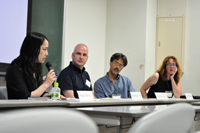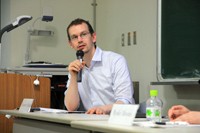| 第6回大会報告 | Modes of Cinematic Power |
|---|
Roundtable: Modes of Cinematic Power
Report: Alexander Zahlten
シンポジウム「映画的力/権力の諸様態」は、力/権力(power)の問題を扱うにあたっての幅広い方法論を提示した。それは、運動するイメージの体系的文脈とそれに対する学術的アプローチの双方が第二次世界大戦終結以来経てきた様々な段階を反映している。こうした方法論の広がりは、三つ組みの——あるいは今回の場合、四つ組みの——アプローチを許容することで、映画的力/権力の本質、あるいはそれについて省察するために適用される方法の本質に到達することを意図してのものではない。むしろそれは、一方で映画的なものが参与している力/権力の諸様態の変容、他方でそれらに適用される理論的モデルとその権力構造の変容、という二つの変位する側面をとりもつ或る関係性を問題化するのである。
御園生涼子とイノウエ・コータの発表がそれぞれ、国家と正統性(御園生)、可視性の地政学的問題(イノウエ)に関わる諸言説に焦点を合わせていた一方で、ジョナサン・ホールとアレキサンダー・ツァールテンは、運動するイメージの諸言説についての言説を検討した。ともに綿密なテクスト読解により、御園生はとりわけ大島渚『絞死刑』における個人と国家の関係に注目し、イノウエは『ゴジラ』における合衆国の消去について検討した。他方でホールは英語圏の日本映画研究における美学概念を検討するために「無言の力(mute power)」概念を導入し、ツァールテンはポスト構造主義理論における自己言及性と後期資本主義時代のトランスメディア作品のあいだに見られるアナロジーに着目した。
アン・マクナイト(UCLAテラサキ日本研究センター)のコメントは、それぞれの発表にまたがるpowerの概念を解きほぐすことから始まった。彼女がそこに認めたのは、国家権力という含意、そして諸々の実在物に作用するアクターという含意をともなう「権力」、実在物のあいだで作用する力としての「力(関係)」、流動的なネットワーク・システムやある種の創造、変転、消費の再配分と関係づけられる「(原子)力」、そして最後に、自己規定の問題と関わるマイナーな力である。続いて彼女は、それぞれのアプローチ間の境界を検討し、重なり合いを指摘するべく、各発表に寄り添ったいくつかの質問を投げかけた。なかでも、イノウエ・コータに対しては、映画史の役割にとって表象の「増加」がどのような帰結をもたらしうるかという質問、御園生涼子に対しては、とりわけ『絞死刑』において登場人物Rが担っている抽象的な性質との関連において、大島渚が挑戦している映画的フレームをめぐる質問が投げかけられた。また、アレクサンダー・ツァールテンに対しては、森村泰昌をめぐる前日の討議におけるペルソナ概念が、理論における自己言及性と後期資本主義の連関からのある種の逃避を可能にするかどうかという質問、ジョナサン・ホールに対しては、支配という問題含みのシステムを「捨て去るunlearn」にあたっての「無言の力」という概念の潜在力をめぐって質問がなされた。
パネルは、聴衆からの多くの啓発的な質問とともに閉じられた。それらはおおむね、権力の力学とその連関をめぐる個別の質問であり、例えば映画における主体性と言説が権力と持つ関係(ホールに対して)、手書き文字といった形式的ツールの映画における使用(御園生に対して)、シリーズ化と異なるバージョンの問題(イノウエに対して)、トランスメディア作品に固有の役割(ツァールテンに対して)などについて質問が提起された。議論はその後、運動するイメージに媒介された映画的力/権力と理論に媒介された映画的力/権力の両者のより広範囲かつ変位し続ける関係を問題化するところへと向かおうとしていた。残念ながら時間の制約により十分に展開できなかったこのトピックについては今後、議論の機会を持ちたい。(アレキサンダー・ツァールテン/韓国、東国大学校、訳:門林岳史)
The panel on ‘Modes of Cinematic Power’ presented a broad array of methodologies in dealing with the problem of power. These reflected the different stages both the systemic context of moving images and the scholarly approaches towards them have gone through since the end of WWII. This breadth was not intended to allow for a triangulation – or in this case quadrangulation – of approaches in order to arrive at an essence of either cinematic power or the method to be applied in reflecting on it. Rather it served to problematize a relation linking two shifting sides: On the one hand the transforming modes of power that the cinematic participates in, and on the other hand the transforming theoretical models applied to them and their inherent power structures.
While Misono Ryoko and Inoue Kôta’s papers focused on discourses involving the state and legitimacy (Misono) and geopolitical questions of visibility (Inoue), Jonathan Hall and Alexander Zahlten looked at the discourse on the discourses of moving images. Specifically Misono focused on the relation of individual and state in Ôshima Nagisa’s Death by Hanging / Kôshikei and Inoue examined the disappearance of the United States in Godzilla / Gôjira, both relying on close textual readings. On the other hand Hall introduced the concept of ‘mute power’ to examine the concept of aesthetics in English-language scholarship on film from Japan, and Zahlten focused on the analogies between self-referentiality in post-structuralist theory and late-capitalist transmedia works.
Anne McKnight of the Terasaki Center for Japanese Studies at UCLA began her comments with a disentangling of the concepts of power she detected across the different papers: 権力, with its implications of state power and actors acting on entities; 力(関係), with forces in operation between entities; (原子)力, which she related to networked systems in flux and the redistribution of kinds of creation, transformation, and expenditure; and finally minor power, which related to the problem of self-determination. She then moved on to more specific questions for each paper in order to test the limits of and detect the overlaps between each separate approach. Among other questions, to Inoue Kôta she asked what consequences an “increase” in representation would have for the role of film history; to Misono Ryoko she inquired about the question of the cinematic frame that Ôshima Nagisa was challenging, especially in relation to the abstract nature that the character “R” takes in the film; to Alexander Zahlten she posed the question if the concept of persona, discussed on the previous day in the panel on Morimura Yasumasa, would enable some kind of escape from the interlocking of the self-reflexivity in theory and late- capitalism; and to Jonathan Hall she asked about the potential of the concept of ‘mute power’ in terms of “unlearning” problematic systems of domination.
The panel ended with a number of illuminating questions from the audience. These were largely focused on specific questions of power dynamics and their relation, for example, to subjectivity and discourse on film (to Hall), the use of formal tools such as calligraphy in film (to Misono) to the problem of seriality and alternative versions (to Inoue) and the specific role of transmedia works (to Zahlten). The discussion was about to turn towards the problematization of the larger and shifting relationship of cinematic power through moving images and cinematic power through theory, but sadly the time did not allow for it, and this topic must be left to future venues.
Alexander Zahlten (Dongguk University, South Korea)
【Abstract of panel】
The notion of power and its specific relation to the cinematic form has been at the center of discussions of the medium from the beginning. A multitude of approaches influenced by the social sciences, Marxism, psychoanalysis and others have emerged that strive to locate an essential power structure of the cinema, many of which by the late 20th century had descended into academic mannerism. More recently there have been attempts to reevaluate the relations of power and the moving image and the respective conception of power they imply, informed directly or indirectly by the enormous sociotechnological shifts of the last 20 years.
This panel will present an array of approaches to the question of cinematic power, focusing on moving images and their connected theoretical and socioeconomic practice in Japan from the 1950s to today. These investigations are not meant to trigger a new theoretical dominant. Instead they aim for a pluralization of the problem of power, one that conceptualizes it as a constellation of modes with differing systemic traits and territories of efficacy. The panel thus also aims to generate discussion on the historical relations, and possibly interactions and contradictions, of these different modes.
【Abstracts of papers】
Japan as Disaster: Gojira in the 21st Century
Kota Inoue (University of Redlands, USA)
The Great Tohoku Earthquake brought an unprecedented level of destruction. While the quake and the tsunami caused most of physical damage and deaths, the leaking radiation poses even larger problem. Prompted by the unfolding disaster in Japan, this paper revisits one of the most frequently discussed films in relation to nuclear destruction, Gojira (1954), and re-evaluates its relevance to our troubled situation in the 21st century.
If Rey Chow underscored the visuality of the atomic blast in her discussion of the world as a target, and by doing so suggested epistemic implications in cinematic representations, Gojira’s mode of destruction, which conspicuously lacks the iconic mushroom cloud image, helps us further develop theories of cinematic power, just as we face invisible radiation threat in real life. Furthermore, as recent studies have pointed out, Gojira, a disaster movie that consciously visualizes destruction while keeping Japan’s postwar subtly invisible, is invested in a particular representation of history. Therefore, the film offers an opportunity to examine another—rather classic—issue of power in film studies: ideology in cinematic representation. This paper will especially focus on the way the film simultaneously embraces and resists the Cold War ideology of the U.S., opening up a path to examine the U.S. hegemony in our own times.
Suspension of the Law: Function of State and Enunciating Subject in Oshima Nagisa's Death by Hanging (1968)
Misono Ryoko (Waseda University)
At the beginning of the year 1968, when the student movement was heated on a global scale, Oshima Nagisa released a provocative film titled Koushikei (Death by Hanging). In the trailer of this film, Oshima took the role of narration, addressing his words using the first personal pronoun “we,” to the audience who designated by the second personal pronoun “you.” This rhetorical contrivance designed to address directly the audience made Oshima to make this film not only a piece of work defined as “Art”, but also as an “event” which occurred in a specific temporal and spatial standpoint. In this act of enunciation situated in the historical context of the late 1960s Japan, Oshima and the members of his production Souzousha questioned the axiomatic nature of the State through an analysis of the death penalty system. This paper examines how Oshima explored the motif of death penalty (and the failure to deliver death penalty) in the geographical framework of modern Japan and its relation to Korea, Japan’s internal “Other.” In so doing, I will elucidate this film as a distinguished analysis of the system of the State as the legal and territorial institution.
At Play in the World: The Re-Installment of the Relation of World and Play and the Role of Anime
Alexander Zahlten (Dongguk University, South Korea)
The tropes of “world” and “play” have experienced a resounding comeback in contemporary theory, be it in the works of Jean-Luc Nancy, Alain Badiou or the rediscovery of philosopher Eugen Fink. Yet this is not only a phenomenon of deliberate reflection; in popular culture there has been a similar rebound that can be seen as a vernacular version of philosophical, sociological or media-theoretical formulations.
This paper will use anime works such as the .hack/ series, which deals explicitly with the question of digital media games, or Higurashi no Naku Koro Ni, which works against its own status as a game to achieve its effects, to map how these themes are negotiated through anime both on the levels of text and practice. Anime will in this case be defined not as a genre or subgenre of animation, but rather as a coordinating nexus of various media, and the focus will be strongly on its transmedia effects. It will explore the shifts in the new modalities of power that anime implies, is subject to, and helps enforce. It will then attempt to draw conclusions for larger developments in media societies.
Mute Power: Political Theory in Contemporary Film Criticism
Jonathan M. Hall (Pomona College, USA)
Describing “aesthetic acts” as instigating “new modes of sense perception and … novel forms of political subjectivity,” Jacques Rancière ponders the status of the image within contemporary critical discourse at the same time as refusing the foreclosure of nostalgic, emancipatory logics. The trajectory of the latter according to Rancière, begins with early century avant-gardism, moves through the crisis of 1960s radical critique, and settles into the late century “routine of discenchanted discourse that acts as the ‘critical’ stand-in for the existing order.” I survey the function of such “disenchanted discourse” within the critical Japan film studies field. On the one hand, I understand how a collectivist and revolutionary logic is both analyzed and productively re-inhabited by recent film historical archaeology (Hirasawa, Nornes, and others), while on the other I bring to this same problematic a biopolitical and discursive conception influenced by both Benjamin and Foucault (Nakazato, Spivak, Ukai, and others). My goal is not to juxtapose Marxist vs. postcolonial political expression, but rather to find within both Japanese film and its theories a movement beyond “the conquests of artistic innovation” and “the victories of emancipation.” Films referenced include work by Adachi Masao and Higashi Yôichi.

撮影:杉山博昭

撮影:旦部辰徳